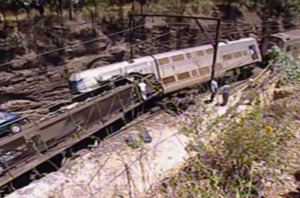Time 8:22 am Type of incident Collision Date 2 December 1999 Injuries 51 | Country Australia Trains 2 Total number of deaths 7 | |
 | ||
Rail line Blue Mountains railway line Similar Waterfall rail accident, Granville rail disaster, Cowan rail accident, 1999 Bourbonnais - Illinois - tr, Spa Road Junction rail crash | ||
The Glenbrook rail accident occurred on 2 December 1999 at 8:22 am on a curve east of Glenbrook railway station on the CityRail network between Glenbrook and Lapstone, in the Blue Mountains of New South Wales, Australia. Seven passengers were killed and 51 passengers were taken to hospital with injuries when a CityRail electric interurban train collided with the rear wagon of the long-haul Perth-to-Sydney Indian Pacific.
Contents
Overview
The Indian Pacific train was authorised to pass a red signal at Glenbrook and stopped at the next signal, also red. The driver alighted to use the lineside signal telephone to call the Signaller for authority to pass the signal at danger; as a component of the phone was missing, he incorrectly believed it to be defective. A delay of approximately seven minutes resulted despite the locomotive having a radio (at that time it was not procedure for the National Rail Corporation to use radio to contact signal boxes).
The interurban train restarted with authority after stopping at the red signal at Glenbrook and collided shortly after with the rear of the Indian Pacific train waiting at the second failed signal. A number of factors were involved, from equipment breakdown to poor phrasing of the safeworking rules: the most important was that the interurban picked up too much speed and the driver was not able to see the rear of the Indian Pacific around a sharp curve in a deep cutting in time to avoid a collision.
Visibility
The track was curved to the left, the train was using the left-hand track, the driver was sitting on the left side of the train, and the track was in a narrow rock cutting. These four factors contributed to less than average visibility.
Inquiry
A Commission of Inquiry headed by Justice Peter McInerny investigated the accident.
Causes
The Commission found that the accident occurred after a power failure disabled two consecutive automatic signals: due to their fail-safe design, both exhibited danger (red).
Both trains obtained permission from the signalman at Penrith to pass the first signal at danger. The driver of the Indian Pacific obeyed the rule requiring him to proceed with "extreme caution", but the driver of the interurban train failed to do so and caught up with the Indian Pacific.
The Commission found fault with a number of procedures, their application by railway employees, and the training those employees had received. Among other factors, it found that:
Effects
The seven people who died were in the front compartment of the first carriage of the interurban train. The rear carriage of the Indian Pacific was a car transport wagon that did not convey passengers, and, in absorbing the brunt of the collision, was arguably the reason there were not any further fatalities on board the Indian Pacific. The impact of the collision was such that the front six metres of the interurban car were compressed into just one metre, while the first six carriages of the Indian Pacific were separated from the rest of the train from the force. When the driver of the CityRail train, Kevin Sinnett, saw the stationary Indian Pacific, he ran from the driver's compartment (the dead-man's brake was automatically activated) to the lower deck of the double-decker carriage warning the passengers to brace themselves. He was badly injured, but survived because of this. As he ran through, a man from the front compartment ran to the upper deck to warn passengers and thereby also survived the crash.
A third train, bound for Lithgow, only narrowly avoided colliding with the wreckage when signallers managed to warn the driver to stop just 60 seconds before it reached the crash site.
The interurban train
The train was a standard four-car V set, labelled V21.The first carriage, DIM8067, received critical damage to its front and lower compartments, but it was repaired. To avoid any reference and insensitivity to the victims, it was re-numbered DIM8020 and remained in service until it was withdrawn in 2003 following many problems.
